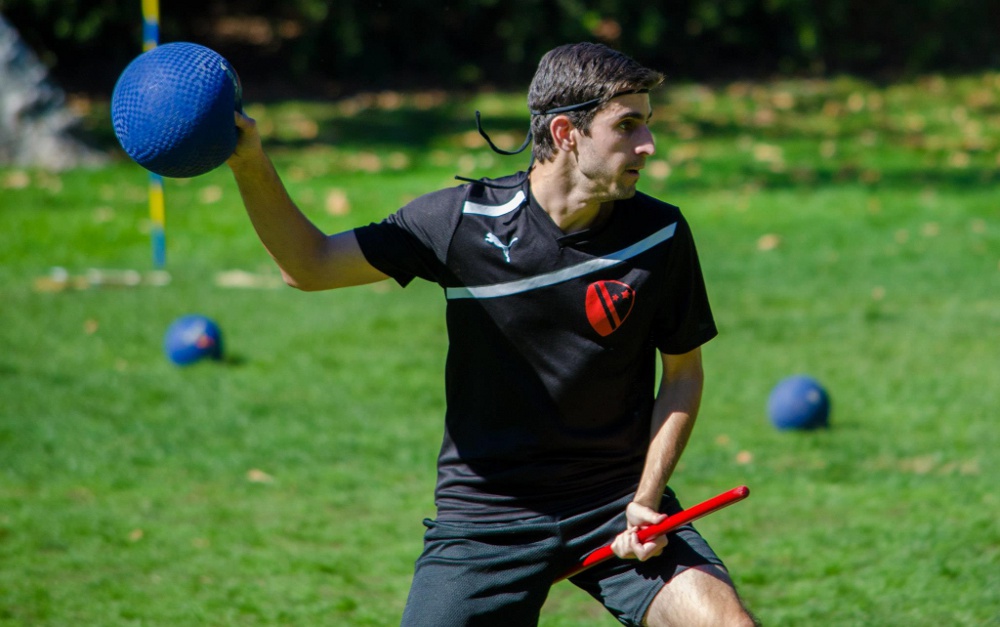- Rule, Britannia, no more?
- Unpopular Opinions: US Quadball Cup 2023
- Proven Contenders: University of Virginia
- Proven Contenders: Rutgers University
- Proven Contenders: University of Michigan
- Proven Contenders: Creighton University
- Different Perspectives: A Look Inside USA Ultimate
- Antwerp QC, Much of Belgian Core, Leaves Competitive Quidditch
Beaters: Aggressive or Conservative?
- Updated: November 7, 2012


Beater Michael Mohlman from The Lost Boys prepares to face the opposition, using his bludger to put pressure on their chasers. Credit: Kat Ignatova
There are many different ways to play the beater position, and all of them can be effective. This article will focus on four main styles: Aggressive offense, aggressive defense, conservative offense, and conservative defense. There are many more ways that lie in between these methods, but for the most part, every high-level team will fit two of these strategies.
Aggressive Offense
If you play aggressively on offense, it mostly means that you will always bring up at least one bludger to assist in clearing a path for your chasers. Some teams, like No. 10 Ball State, whom I’ll be using as the archetype of the aggressive beater offense, oftentimes bring up both bludgers, giving their chasers a very easy path to the goal. This strategy is highly effective in putting points on the board, as it often leads to a temporarily bludgerless defense. Ball State is able to be highly effective with this strategy because they have very tough, powerful chasers who can get through just about anybody, so when they’re left with a bludgerless defense, it almost always results in a goal.
This strategy is not without its drawbacks though. If the defense is able to force a turnover, you won’t have any beaters back to defend against the fast break, which means you have to be very trusting of your chasers. Again, Ball State is able to use their aggressive strategy to great effect because their chasers are all great tacklers, and can usually stop a chaser in the open field.
There are, however, varying degrees of the aggressive offense. When I was playing alongside Ball State chaser Devon McCoy at Midwest Fantasy, the clash of styles was very apparent. Ohio State (OSU) plays a more conservative game (we’ll get to that later), and McCoy was used to his beaters taking out the defensive beaters. So, I went on offense, but instead of throwing at the defensive beaters, I simply got close enough to be a threat, which took their attention off of Devon, who was then easily able to score. I was able to play aggressive in positioning, but conservative in my throwing, and it worked to great effect. The point being that there are many ways to effectively utilize your beaters on offense.
Conservative Offense
This one seems simple: you just don’t bring your beaters up on offense, right? Not quite. A conservative bludger offense is highly dependent on bludger control. If your team has bludger control, then both beaters can stay back. But, if you do not have bludger control, you will likely have to send your bludger on offense to work to regain control. OSU used to try to send only the bludgerless beater in these situations. Then University of Maryland gave us a big lesson on why that doesn’t work. Against a top team where all the beaters know very well how to hang onto a bludger, it’s almost impossible to regain control without sending a bludger on offense.
The main difference between a conservative and aggressive beater offense is that in a conservative offense, you typically only send a bludger on offense when you are trying to regain bludger control, whereas in an aggressive offense, you send your bludgers forward in order to directly assist in scoring. Neither strategy is definitively better, as was proven in the finals of Phoenix Cup, where OSU’s conservative play was just about exactly equal to Ball State’s aggressive play. It all depends on which works best for your team and which you’re most comfortable with.
Aggressive Defense
An aggressive bludger defense can mean a couple different things. It could mean that you apply high pressure with your beaters in an attempt to force turnovers, or it could mean that you are very liberal with your bludgers and throw at every opportunity.
In an aggressive defense which utilizes high-pressure, you will typically see a beater playing man-to-man on the quaffle-carrier. This beater then has several options:
- Take an angle that forces the quaffle-carrier towards the sidelines, giving her a bad angle for a shot.
- Use a lot of pump fakes to make the quaffle-carrier uncomfortable, forcing her into a bad pass or a bad shot.
- Get close enough to take a high-percentage throw with an easily regained rebound.
In this way, the high-pressure aggressive defense is kind of a conservative aggression. Not a lot of throws, but very aggressive in positioning.
The most aggressive type of beater defense is the throw-heavy defense. In this strategy, which honestly, has almost fallen by the wayside, beaters throw relentlessly, almost without discretion. You don’t see a whole lot of top teams doing this, mostly because there are many effective ways to play defense, and this way is the way that will most easily lose your bludger control. This strategy has evolved, for the most part, into a strategy where your beaters will pick off the opposing team’s off-ball chasers and hope that your chasers are able to bring down the ball carrier with little to no beater support. However, some teams with stellar beaters will still be able to take a lot of throws at the quaffle-carrier and have it be very effective. You have to have a beater you trust completely, and one that is willing to put in a lot of effort to regain control of her bludger. In this style of defense, the beater will typically remain towards the middle of the pitch, taking away the opposition’s best angles of attack on the hoops.
Conservative Defense
In a conservative bludger defense, beaters will typically stand close to the hoops, with the hope that if they get beat, they’ll be able to remount and regain their bludger quickly. This strategy is highly effective in retaining bludger control and preventing power chasers from getting close to the hoops. However, it is not highly effective in forcing turnovers, and can leave your defense vulnerable to long shots.
The conservative defense almost never throws a bludger, and relies on the chasers to defend on the perimeter. The beaters will, of course, step up and throw if the chasers do not defend successfully, but the most effective conservative bludger defenses are complimented by outstanding chaser defense.
In the end, there are many different ways to play the beater position, and the only way to know which one works best for you and your team is to try them all, try combinations of different styles, or create your own way that has never been done before.
